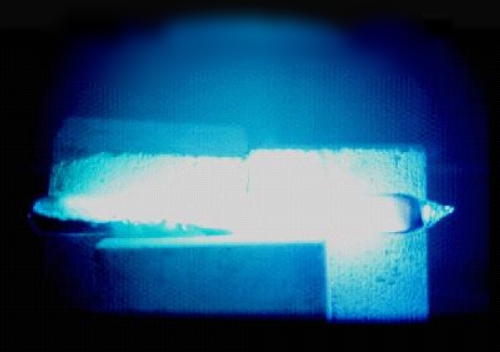|
|
 |
|||
|
Synthesis of chromium sulphide under microwave irradiation The following pictures illustrate the dramatic progress of a reaction between chromium powder (-200 mesh), and sulphur powder in a sealed, evacuated, silica ampoule.
When placed under microwave irradiation (600W), the reactants heat extremely rapidly - a measured rate of up to 100K/Sec - to give a low pressure of sulphur vapour in which a bright plasma rapidly forms:
The heat of the reaction is soon (approximately 10 seconds) hot enough for the reactants to react, and this exothermic reaction produces red and white sparks together with a green film of liquid sulphur against the blue plasma backdrop:
After a further 5 minute heating regime, the sulphur is completely combined with the chromium, and the sulphur plasma is extinguished. First row transition metal sulphides tend to be electrical conductors, so enabling microwave heating to continue in the product. This allows the product to be annealed to give materials which are thermodynamically unstable at the high temperatures of the combination reaction, such as Cr5S6. Moreover, there is evidence that microwave heating may actively transport metal ions so requiring shorter annealing and sintering periods in solid-state syntheses.
The chromium sulphide being annealed with microwaves This synthetic method has been employed in the synthesis of a range of metal chalcogenides, including CrS, Cr5S6, Cr7S8, Fe7S8, CrS, Cr5Se6, Cr2S3, TaS2 (2H polytype), SnS2, CuS. Interestingly, Landry and Barron extended the method to the synthesis of the important semiconductor materials CuInS2,CuInSe2, and CuInSSe. |
|||
